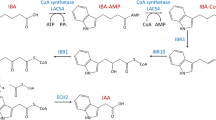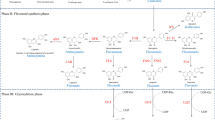Abstract
Wheat allelopathy has potential for weed suppression. Allelochemicals were identified in wheat seedlings, and they were exuded from seedlings into agar growth medium. p-Hydroxybenzoic, trans-p-coumaric, cis-p-coumaric, syringic, vanillic, trans-ferulic, and cis-ferulic acids and 2,4-dihydroxy-7-methoxy-1,4-benzoxazin-3-one (DIMBOA) were identified in both the shoots and roots of 17-day-old wheat seedlings and their associated agar growth medium. Wheat accessions with previously identified allelopathic activity tended to contain higher levels of allelochemicals than poorly allelopathic ones. The allelopathic compounds present in the shoots generally also were identified in the roots and in the agar medium. Allelochemicals were distributed differentially in wheat, with roots normally containing higher levels of allelochemicals than the shoots. When the eight allelochemicals were grouped into benzoic acid and cinnamic acid derivatives, DIMBOA, total coumaric, and total ferulic acids, the amount of each group of allelochemicals was correlated between the roots and the shoots. Most of the allelochemicals identified in the shoots and roots could be exuded by the living roots of wheat seedling into the agar growth medium. However, the amounts of allelochemicals in the agar growth medium were not proportional to those in the roots. Results suggest that wheat plants may retain allelochemicals once synthesized. The presence of allelochemicals in the agar growth medium demonstrated that wheat seedlings were able to synthesize and to exude phytotoxic compounds through their root system that could inhibit the root growth of annual ryegrass.
Similar content being viewed by others
REFERENCES
An, M. 1995. Allelopathy in vulpia residue. PhD dissertation. Charles Sturt University, Wagga Wagga, Australia.
An, M., Pratley, J., and Haig, T. 1998. Allelopathy: from concept to reality, pp. 563–566, in D. L. Michalk and J. E. Pratley (eds.). Proceedings, 9th Australian Agronomy Conference, Wagga Wagga, Australia.
Copaja, S. V., Niemeyer, H. M., and Wratten, S. D. 1991. Hydroxamic acid levels in Chilean and British wheat seedlings. Ann. App. Appl. Biol. 118:223–227.
Dilday, R. H., Lin, J., and Yan, W. 1994. Identification of allelopathy in the USDA-ARS rice germplasm collection. Aust. J. Exp. Agric. 34:907–910.
Einhellig, F. A. 1996. Interactions involving allelopathy in cropping systems. Agron. J. 88:886–893.
Einhellig, F. A., and Souza, I. F. 1992. Phytotoxicity of sorgoleone found in grain sorghum root exudates. J. Chem. Ecol. 18:1–11.
Fay, P. K., and Duke, W. B. 1977. An assessment of allelopathic potential in Avena germplasm. Weed Sci. 25:224–228.
Fisher, R. F. 1979. Allelopathy, pp. 313–330, in J. G. Horsfall and E. B. Cowling (eds.). Plant Disease: An Advanced Treatise. Academic Press. New York.
Foy, C. L., Hurtt, W., and Hale, M. G. 1971. Root exudation of plant-growth regulators, pp. 75–85, in U.S. National Committee for IBP (ed.). Biochemical Interactions Among Plants. National Academy Science, Washington, D.C.
Gershenzon, J. 1984. Changes in the level of plant secondary metabolites under water and nutrient stress. Recent Adv. Phytochem. 18:273–320.
Guenzi, W. D., and McCalla, T. M. 1966. Phenolic acids in oats, wheat, sorghum, and corn residues and their phytotoxicity. Agron. J. 58:303–304.
Guenzi, W. D., McCalla, T. M., and Norstadt, F. A. 1967. Presence and persistence of phytotoxic substances in wheat, oat, corn and sorghum residues. Agron. J. 59:163–165.
Hahlbrock, K., and Scheel, D. 1989. Physiology and molecular biology of phenylpropanoid metabolism. Annu. Rev. Plant Physiol. Plant Mol. Biol. 40:347–369.
Inderjit. 1996. Plant phenolics in allelopathy. Bot. Rev. 62:186–202.
Kimber, R. W. L. 1967. Phytotoxicity from plant residues. I. The influence of rotted wheat straw on seedling growth. Aust. J. Agric. Res. 18:361–374.
Kobayashi, A., Kim, M. J., and Kawazu, K. 1996. Uptake and exudation of phenolic compounds by wheat and antimicrobial components of the root exudate. Z. Naturforsch. 51c:527–533.
Lodhi, M. A. K., Bilal, R., and Malik, K. A. 1987. Allelopathy in agroecosystems: Wheat phytotoxicity and its possible roles in crop rotation. J. Chem. Ecol. 13:1881–1891.
Lynn, D. G., and Chang, M. 1990. Phenolic signals in cohabitation: Implication for plant development. Annu. Rev. Plant Physiol. Plant Mol. Biol. 41:497–526.
Nicol, D., Copaja, S. V., Wratten, S. D., and Niemeyer, H. M. 1992. A screen of worldwide wheat cultivars for hydroxamic acid levels and aphid antixenosis. Ann. Appl. Biol. 121:11–18.
Niemeyer, H. M. 1988a. Hydroxamic acids (4-hydroxy-1,4-benzoxazin-3-one), defence chemicals in the gramineae. Phytochemistry 27:3349–3358.
Niemeyer, H. M. 1988b. Hydroxamic acid content of triticum species. Euphytica 37:289–293.
Olofsdotter, M., and Navarez, D. C. 1996. Allelopathic rice for Echinochloa crus-galli control, pp. 1175–1181, in H. Brown, G. W. Cussans, M. D. Devine, S. O. Duke, C. Fernadez-Quintanilla, A. Helweg, R. E. Labrada, M. Landes, P. Kudsk, and J. C. Streibig (eds.). Proceedings, 2nd International Weed Control Congress. Copenhagen, Denmark.
Overland, L. 1966. The role of allelopathic substances in the “smother crop” barley. Am. J. Bot. 53:423–432.
PÉrez, F. J. 1990. Allelopathic effect of hydroxamic acids from cereals on Avena sativa and A. fatua. Phytochemistry 29:773–776.
PÉrez, F. J., and OrmeÑo-NÚÑez, J. 1991. Difference in hydroxamic acid content in roots and root exudates of wheat (Triticum aestivum L.) and rye (Secale cereale L.): Possible role in allelopathy. J. Chem. Ecol. 17:1037–1043.
Pratley, J. E. 1996. Allelopathy in annual grasses. Plant Prot. Q. 11(Suppl 1):213–214.
Putnam, A. R., and Duke, W. B. 1974. Biological suppression of weeds: Evidence for allelopathy in accessions of cucumber. Science 185:370–372.
Rice, E. L. 1984. Allelopathy, 2nd ed. Academic Press, Orlando, Florida.
Spruell, J. A. 1984. Allelopathic potential of wheat accessions. Diss. Abstr. Int. B 45:1102B.
Tang, C. S., and Young, C. C. 1982. Collection and identification of allelopathic compounds for the undisturbed root system of bigatta limpograss (Hemarthia altissima). Plant Physiol. 69:155–160.
Van Pelt, C. K., Haggarty, H., and Brenna, J. T. 1998. Quantitative subfemtomole analysis of a-tocopherol and deuterated isotopomers in plasma using tabletop GC-MS-MS. Anal. Chem. 70:4369–4375.
Wu, H., Pratley, J., Lemerle, D., Haig, T., and Verbeek, B. 1998. Differential allelopathic potential among wheat accessions to annual ryegrass, pp. 567–571, in D. L. Michalk and J. E. Pratley (eds.). Proceedings, 9th Australian Agronomy Conference, Wagga Wagga, Australia.
Wu, H., Pratley, J., Lemerle, D., and Haig, T. 1999a. Crop cultivars with allelopathic capability. Weed Res. 39:171–180.
Wu, H., Haig, T., Pratley, J., Lemerle, D., and An, M. 1999b. Simultaneous determination of phenolic acids and 2,4-dihydroxy-7-methoxy-1,4-benzoxazin-3-one by GC-MS-MS in wheat (Triticum aestivum). J. Chromatogr. A 864:315–321.
Wu, H., Pratley, J., Lemerle, D., and Haig, T. 2000. Laboratory screening for allelopathic potential of wheat (Triticum aestivum) accessions against annual ryegrass (Lolium rigidum). Aust. J. Agric. Res. 51:259–266.
Author information
Authors and Affiliations
Rights and permissions
About this article
Cite this article
Wu, H., Haig, T., Pratley, J. et al. Distribution and Exudation of Allelochemicals in Wheat Triticum aestivum. J Chem Ecol 26, 2141–2154 (2000). https://doi.org/10.1023/A:1005520500110
Issue Date:
DOI: https://doi.org/10.1023/A:1005520500110




